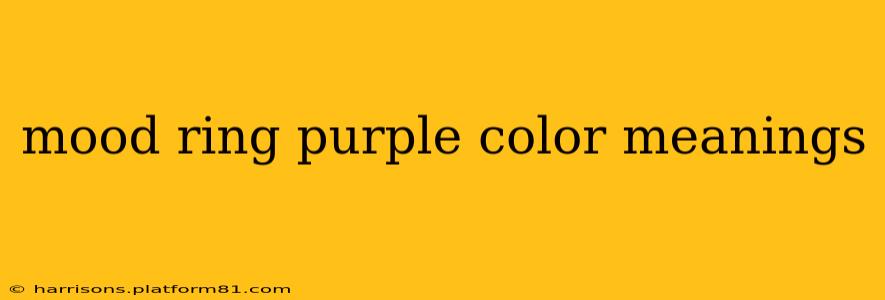Mood rings, those captivating pieces of jewelry that seemingly change color with your emotions, have fascinated people for decades. While the science behind their color-changing abilities is debated (it's primarily due to thermochromic liquid crystals reacting to temperature changes, not emotions directly), their allure remains. Understanding the purported meanings associated with each color, particularly purple, can add another layer of intrigue to these enigmatic rings.
This article delves into the various shades of purple in a mood ring and their associated meanings, providing a comprehensive guide to interpreting the subtle shifts in color. We'll also address some frequently asked questions surrounding mood rings and their accuracy.
What Does a Purple Mood Ring Mean?
The meaning attributed to purple in a mood ring generally centers around themes of wisdom, creativity, and independence. However, the shade of purple is crucial. A deep, rich amethyst suggests a balanced emotional state, possibly even hinting at a spiritual awakening or connection. A lighter, lavender-toned purple might signify a more playful, imaginative mood, or perhaps a time of self-discovery.
The nuances of purple in a mood ring can be subtle, and interpretations often vary. There's no single definitive answer; rather, it's about understanding the general symbolic associations and considering your personal feelings at the moment.
What are the Different Shades of Purple in a Mood Ring and Their Meanings?
Mood rings rarely display pure, unmixed colors. Shades often blend, creating a spectrum of purples that can subtly shift. Here's a breakdown of some common purple hues and their potential interpretations:
-
Deep Amethyst Purple: This rich, dark shade is often associated with feelings of wisdom, inner peace, and spiritual connection. It can suggest a calm, balanced state, a time of introspection, or a moment of clarity and understanding.
-
Lavender Purple: Lighter and more delicate, this shade is often linked to creativity, imagination, and playfulness. It might indicate a lighthearted, joyful mood or a period of self-expression.
-
Lilac Purple: A soft, pale purple, lilac often symbolizes sensitivity, gentleness, and a connection to your intuition. It could suggest a time of introspection or a need for nurturing and self-care.
Remember that these interpretations are subjective and may not resonate with everyone. The most important thing is to pay attention to your own feelings and how they relate to the color you're seeing.
Are Mood Rings Accurate?
This is a question frequently asked about mood rings. The short answer is: not directly. Mood rings don't actually detect emotions; they respond to changes in skin temperature. Your body temperature fluctuates based on various factors, including stress, physical activity, and even the ambient temperature. While certain emotional states might correlate with temperature changes, it's not a direct, reliable measure of your emotions.
How Accurate are Mood Ring Color Meanings?
The accuracy of mood ring color meanings is entirely dependent on the individual's interpretation and belief. There's no scientific validation behind the specific emotional correlations assigned to each color. They're more of a fun, suggestive guide than a precise emotional barometer.
What Factors Affect Mood Ring Color Changes?
Several factors influence a mood ring's color:
- Body Temperature: This is the primary factor. Stress, exercise, illness, and even the temperature of your surroundings can all affect your skin temperature, and hence, the ring's color.
- Room Temperature: A colder environment will result in a cooler ring temperature and a different color than a warmer one.
- Direct Sunlight: Exposure to intense sunlight can affect the ring's color temporarily.
What Does It Mean When My Mood Ring is Purple All the Time?
If your mood ring consistently displays purple, it could mean your skin temperature tends to remain within a specific range that consistently activates that color. It doesn't necessarily signify you're always in a state associated with purple.
In conclusion, while the science behind mood rings might not be perfectly clear-cut, their symbolism and the fun they provide remain undeniable. Understanding the potential meanings associated with purple, and its many shades, adds another layer of enjoyment to the experience of wearing one. Remember, the interpretations are subjective; pay attention to your own feelings and intuition when decoding your mood ring's colors.
